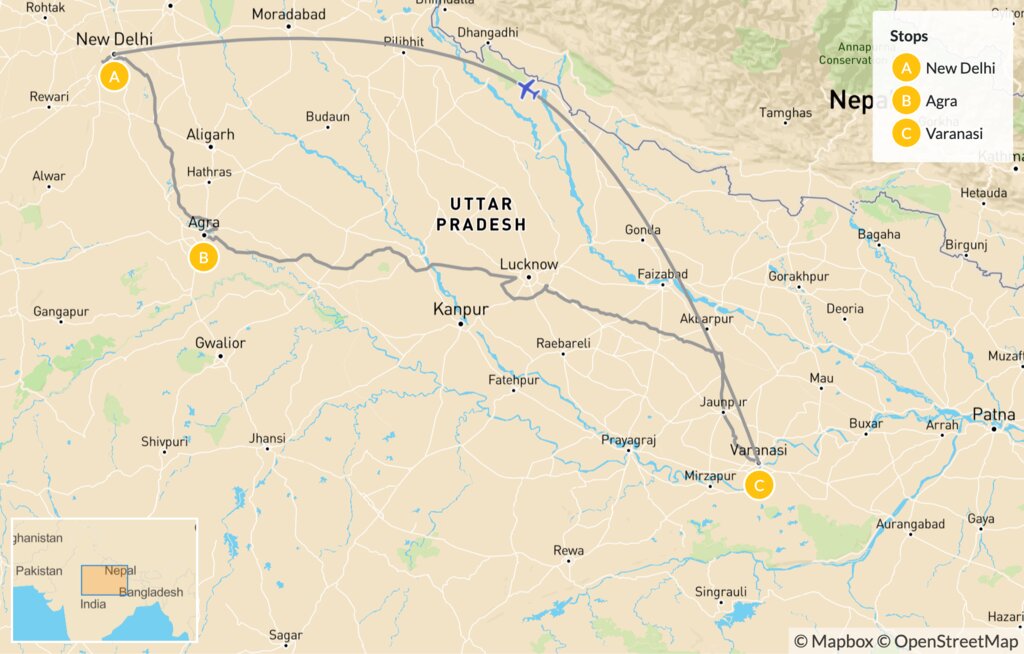Highlights
- Enjoy several different perspectives on the Taj Mahal
- Sample street food delicacies on a food walk through Agra Bazaar
- Experience a spiritual ceremony at dusk on the banks of the Ganges
- Take a yoga class in Varanasi and visit the birthplace of Buddhism in Sarnath
- Watch sari weaving at a traditional market
Brief Itinerary
| Day | Highlights | Overnight |
|---|---|---|
| Day 1 | Arrive in Delhi, Free Time in Delhi | Delhi |
| Day 2 | Transfer to Agra, Visit Agra Fort, View the Taj Mahal from Mehtab Bagh | Agra |
| Day 3 | Taj Mahal at Sunrise, I'timād-ud-Daulah Tomb, Food Walk, Transfer to Varanasi | Varanasi |
| Day 4 | Explore Varanasi's Narrow City Streets, Evening Aarti (Prayer Ceremony) | Varanasi |
| Day 5 | Take a Yoga Class in Varanasi, Watch Sari Weaving, Visit Sarnath | Varanasi |
| Day 6 | Transfer to Delhi, Depart |
Detailed Itinerary
Day 1: Arrive in Delhi, Free Time in Delhi

Day 2: Transfer to Agra, Visit Agra Fort, View the Taj Mahal from Mehtab Bagh

This morning, you'll travel with a private driver to Agra, a city that grew in prominence under the rule of the Mughal Empire from the 16th century on. Akbar, one of the Great Mughal emperors, ruled over one of the most memorable periods in the city's history. It became a leading center of art, science, commerce, and culture, drawing intellectuals and artists to its darbars (royal courts) and havelis (traditional townhouse mansions).
After breakfast, visit Agra Fort, whose mighty red sandstone walls enclose the white marble Pearl Mosque and the palaces, halls, and courtyards of Akbar's sons and successors. Various architectural styles demonstrate the boldness of Akbar's rule, the refinement of Jahangir's time, and the subtlety of Shah Jahan's rule. You'll see the Diwan-i-Am (Hall of Audience), where public grievances were heard, the Diwan-i-Khaas for private receptions, and Jodha Bai's Palace, one of the most prominent palaces commissioned by Akbar.
Day 3: Taj Mahal at Sunrise, I'timād-ud-Daulah Tomb, Food Walk, Transfer to Varanasi

Today at sunrise, you'll get up close to the Taj Mahal to experience its color-changing hues with the rising sun. This 17th-century white marble mausoleum was commissioned for Empress Mumtaz Mahal by her husband, Emperor Shah Jehan. Taking 22 years to complete and over 20,000 craftsmen working around the clock, the Taj Mahal is perhaps one of humanity's greatest testaments to love. No matter how many photos you've seen, nothing compares to seeing it in person.
After breakfast, visit the Tomb of I'timād-ud-Daulah, the first mausoleum built on the bank of the Yamuna River, regarded as the inspiration for the Taj Mahal. Marvel at its intricate marble lattice screens, fine carvings, and pietra dura (colorful stone inlays). It was built for Mirzā Ghiyās Beg, the grandfather of Mumtāz Mahāl for whom the Taj Mahal was built. Visiting this tomb is a breathtaking sight and a great way to understand the legacy of the Taj Mahal.
Day 4: Explore Varanasi's Narrow City Streets, Evening Aarti (Prayer Ceremony)

Chat with a local specialist who can help organize your trip.
Today you'll explore Varanasi on foot. Built in the 11th century on the banks of the Ganges River, Varanasi is widely regarded as the spiritual capital of India, a central place of pilgrimage, death, and mourning in the Hindu world. Thousands of pilgrims, sadhus (religious ascetics), and visitors crowd the streets and ghats (bathing stairs) of the Ganges. Walking Varanasi's narrow streets offers great insight into the life of the people here and the surroundings, which have changed very little over the last few centuries.
After the walking tour, drive with your guide out to the Banaras Hindu University, visit the Indian art museum Bharat Kala Bhawan, and see Shri Kashi Vishwanath Temple. If time allows, you'll also visit the Durga Temple (Monkey Temple), Tulasi Manas Temple, and the Bharat Mata Temple (Mother India Temple). All these temples possess great religious importance in Varanasi.
Day 5: Take a Yoga Class in Varanasi, Watch Sari Weaving, Visit Sarnath

There is no better place to begin or continue your yoga discovery than in Varanasi, one of India's top places for yoga education. Today you'll take a yoga class to learn more about this renowned discipline and experience its healing qualities firsthand. You'll benefit from in-depth knowledge, deep cultural and historical insights, and hands-on instruction in one of the many different types of yoga taught here, from Hatha and Ashtanga to Kundalini, Bikram, and other contemporary versions.
Later today, you'll head to a traditional market to get a glimpse of the shops and lives of people in Varanasi's bazaars. Saris (traditional Indian garments often made from silk) are one of the most distinctive forms of art and cultural heritage in India. Visit silk weavers to learn more about how the famous Banarasi saris (saris made in Varanasi) are woven and what the life of a silk weaver is like. These are some of the finest saris in India, often made with gold and silver brocade, fine silk, and opulent embroidery.
Day 6: Transfer to Delhi, Depart

More Great India Itineraries
Looking for more inspiration for your trip to India? Check out these other India itineraries, explore different ways to spend six days in India, or discover the best time to visit India.


